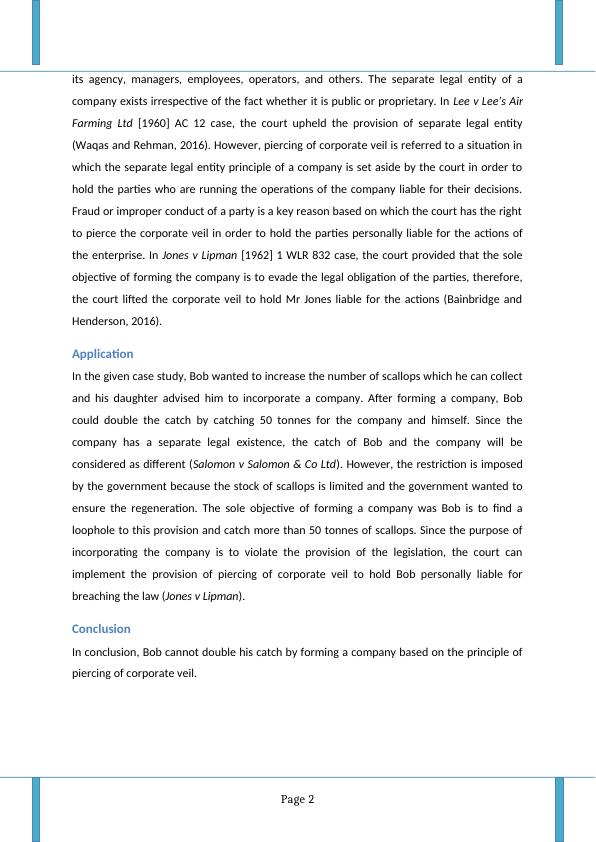Liability of a Holding Company for the Negligence of its Subsidiary
Added on 2023-06-04
9 Pages2477 Words184 Views
Corporations Law

Answer 1
Issue
The key issue, in this case, is whether incorporating a company will allow Bob to increase his
catch?
Rule
The parties operating their business in Australia have the option to choose between
different business structure while operating their business which includes sole trader,
partnership, trust, and company. The company is a common form of business structure
which is selected by parties due to its characteristics which include limited liability and
perpetual succession. A corporation has a separately legal entity in the eyes of the law
based on which it has the right to form a contractual relationship with third parties and it
can sue or get sued as well (Gibson, 2017). These attributes were established by the court in
the remarkable case of Salomon v Salomon & Co Ltd (1897) AC 22. In this case, a suit was
filed by unsecured creditors against Salomon who was the shareholders and debenture
holder of the company. It was argued in the suit that Salomon is the majority shareholder of
the company and the debentures are a sham based on which the payment should be made
to unsecured creditors rather the Salomon for the debentures. The court rejected these
claims by providing that the company and Salomon have separate entities. The company is
liable for its own liabilities regardless of the fact that a party holds the majority of shares in
the company (Kershaw, 2012). Therefore, as per the separate legal entity principle of a
company, the liabilities of its members are limited as well. They cannot be held personally
liable for the debts which are incurred by the enterprise during its operations.
In Australia, the Corporations Act 2001 (Cth) governs the operations of companies. This is
significant legislation which provides the key rights and liabilities of the company and its
members. Section 124 (1) of the Act defines the legal capacities of companies. This section
highlights the powers which a company has based on its legal capacity (Austlii, 2018). This
section provides that the company has the authority to issue or cancel shares, debentures,
registered, and others. These rights provide that the company is different from its
shareholders. Moreover, section 1.5.1 of the act provides that a company is separate from
Page 1
Issue
The key issue, in this case, is whether incorporating a company will allow Bob to increase his
catch?
Rule
The parties operating their business in Australia have the option to choose between
different business structure while operating their business which includes sole trader,
partnership, trust, and company. The company is a common form of business structure
which is selected by parties due to its characteristics which include limited liability and
perpetual succession. A corporation has a separately legal entity in the eyes of the law
based on which it has the right to form a contractual relationship with third parties and it
can sue or get sued as well (Gibson, 2017). These attributes were established by the court in
the remarkable case of Salomon v Salomon & Co Ltd (1897) AC 22. In this case, a suit was
filed by unsecured creditors against Salomon who was the shareholders and debenture
holder of the company. It was argued in the suit that Salomon is the majority shareholder of
the company and the debentures are a sham based on which the payment should be made
to unsecured creditors rather the Salomon for the debentures. The court rejected these
claims by providing that the company and Salomon have separate entities. The company is
liable for its own liabilities regardless of the fact that a party holds the majority of shares in
the company (Kershaw, 2012). Therefore, as per the separate legal entity principle of a
company, the liabilities of its members are limited as well. They cannot be held personally
liable for the debts which are incurred by the enterprise during its operations.
In Australia, the Corporations Act 2001 (Cth) governs the operations of companies. This is
significant legislation which provides the key rights and liabilities of the company and its
members. Section 124 (1) of the Act defines the legal capacities of companies. This section
highlights the powers which a company has based on its legal capacity (Austlii, 2018). This
section provides that the company has the authority to issue or cancel shares, debentures,
registered, and others. These rights provide that the company is different from its
shareholders. Moreover, section 1.5.1 of the act provides that a company is separate from
Page 1

its agency, managers, employees, operators, and others. The separate legal entity of a
company exists irrespective of the fact whether it is public or proprietary. In Lee v Lee’s Air
Farming Ltd [1960] AC 12 case, the court upheld the provision of separate legal entity
(Waqas and Rehman, 2016). However, piercing of corporate veil is referred to a situation in
which the separate legal entity principle of a company is set aside by the court in order to
hold the parties who are running the operations of the company liable for their decisions.
Fraud or improper conduct of a party is a key reason based on which the court has the right
to pierce the corporate veil in order to hold the parties personally liable for the actions of
the enterprise. In Jones v Lipman [1962] 1 WLR 832 case, the court provided that the sole
objective of forming the company is to evade the legal obligation of the parties, therefore,
the court lifted the corporate veil to hold Mr Jones liable for the actions (Bainbridge and
Henderson, 2016).
Application
In the given case study, Bob wanted to increase the number of scallops which he can collect
and his daughter advised him to incorporate a company. After forming a company, Bob
could double the catch by catching 50 tonnes for the company and himself. Since the
company has a separate legal existence, the catch of Bob and the company will be
considered as different (Salomon v Salomon & Co Ltd). However, the restriction is imposed
by the government because the stock of scallops is limited and the government wanted to
ensure the regeneration. The sole objective of forming a company was Bob is to find a
loophole to this provision and catch more than 50 tonnes of scallops. Since the purpose of
incorporating the company is to violate the provision of the legislation, the court can
implement the provision of piercing of corporate veil to hold Bob personally liable for
breaching the law (Jones v Lipman).
Conclusion
In conclusion, Bob cannot double his catch by forming a company based on the principle of
piercing of corporate veil.
Page 2
company exists irrespective of the fact whether it is public or proprietary. In Lee v Lee’s Air
Farming Ltd [1960] AC 12 case, the court upheld the provision of separate legal entity
(Waqas and Rehman, 2016). However, piercing of corporate veil is referred to a situation in
which the separate legal entity principle of a company is set aside by the court in order to
hold the parties who are running the operations of the company liable for their decisions.
Fraud or improper conduct of a party is a key reason based on which the court has the right
to pierce the corporate veil in order to hold the parties personally liable for the actions of
the enterprise. In Jones v Lipman [1962] 1 WLR 832 case, the court provided that the sole
objective of forming the company is to evade the legal obligation of the parties, therefore,
the court lifted the corporate veil to hold Mr Jones liable for the actions (Bainbridge and
Henderson, 2016).
Application
In the given case study, Bob wanted to increase the number of scallops which he can collect
and his daughter advised him to incorporate a company. After forming a company, Bob
could double the catch by catching 50 tonnes for the company and himself. Since the
company has a separate legal existence, the catch of Bob and the company will be
considered as different (Salomon v Salomon & Co Ltd). However, the restriction is imposed
by the government because the stock of scallops is limited and the government wanted to
ensure the regeneration. The sole objective of forming a company was Bob is to find a
loophole to this provision and catch more than 50 tonnes of scallops. Since the purpose of
incorporating the company is to violate the provision of the legislation, the court can
implement the provision of piercing of corporate veil to hold Bob personally liable for
breaching the law (Jones v Lipman).
Conclusion
In conclusion, Bob cannot double his catch by forming a company based on the principle of
piercing of corporate veil.
Page 2

End of preview
Want to access all the pages? Upload your documents or become a member.
Related Documents
Piercing of Corporate Veil in Australian Contextlg...
|13
|3525
|318
Corporation and Contract Law: Evaluating the Role of Piercing of Corporate Veil in Australialg...
|12
|3279
|208
Violation of Director Duties in Corporate Lawlg...
|7
|2464
|293
Current Issues in Corporate Lawlg...
|11
|2691
|180
Liability of members in pre-incorporation contracts and partnership lawlg...
|8
|2130
|179
Corporation Law Assignment | Salomon principlelg...
|9
|2103
|127
